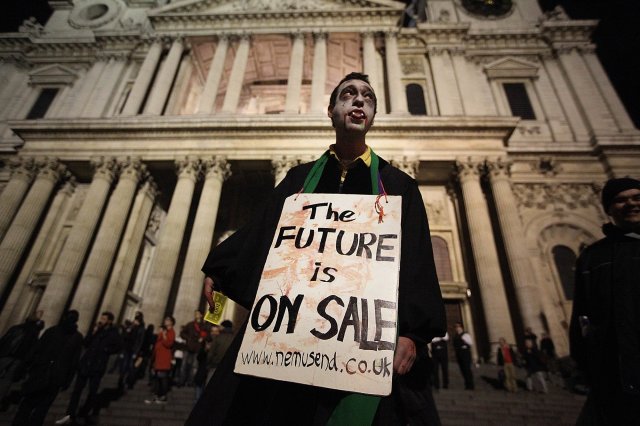They have won. (Peter Macdiarmid/Getty Images)

In a media climate of instant, and often deeply misconceived, reactions, it’s a relief when somebody steps back to take in the bigger picture.
For an example of the latter, you could do a lot worse than read a recent Morgan Housel essay for the Collaborative Fund. In a mere 5,000 very accessible words, Housel offers his hot take on the last 73 years of American economic history – diagnosing the ills of contemporary capitalism along the way.
In the first two or three decades after the war, he says it was all going rather well:
“The defining characteristic of economics in the 1950s is that the country got rich by making the poor less poor.
“Average wages doubled from 1940 to 1948, then doubled again by 1963.”
Housel puts this success story down to the combination of a “hidden productivity boom” dating from the 1930s and a consumer boom following the war – neatly matching demand to supply as production switched back to peacetime needs.
It is true that credit greased the wheels of the postwar economy, with the government keeping interest rates low (and interest on borrowings tax deductible). However, a lot of that easy credit went into expanding home ownership. Moreover, with healthy wage growth, debt levels did not rise beyond manageable bounds:
“Household debt to income today is just over 100%. Even after rising in the 1950s, 1960s, and 1970s, it stayed below 60%…”
But it couldn’t last. The inflationary shocks and rising unemployment of the 1970s derailed the old model, clearing the way for a new kind of economy. There was an apparent return to the good times from the 1980s onward, but with an all-important catch:
“The biggest difference between the economy of the 1945-1973 period and that of the 1982-2000 period was that the same amount of growth found its way into totally different pockets.”
In the first period, the proceeds of growth were evenly shared across society, but not so the second. Housel quotes figures from the Atlantic:
“Between 1993 and 2012, the top 1 percent saw their incomes grow 86.1 percent, while the bottom 99 percent saw just 6.6 percent growth.”
Curiously, slower wage growth did not stop ordinary consumers from continuing to consume. As before, credit bridged the gap – only this time pushing up debt levels without the counterweight of rising incomes or the spread of asset ownership.
The build up of unsustainable debt is a familiar criticism of this period, but Housel links it to another fundamental difference between the two models of post-war consumer capitalism. What distinguished the two eras wasn’t just the sustainability of household debt, but what it was used for.
In the first period (i.e. before the crisis of the 1970s) credit-fuelled consumption was about universalising access to a mainstream, modern lifestyle. Housel emphasises the equality of postwar “lifestyle and consumption expectations” and sets it in contrast to the consumer culture of more recent decades (i.e. the 1980s onwards). This was, and is, shaped by a stark inequality of expectations. Instead of promises of a home everyone can afford, our gaze is drawn to the lifestyles of the rich and famous. Of course, such lifestyle are ultimately unattainable for the great majority (which is what makes them so tantalising), but we can be sold tokens and approximations, designers labels and fakes. We may resent the social stratification of it all, but we also buy – and borrow – into it.
Housel is surely on to something here, but I’d add another big difference between the two eras. The consumer culture of the 1950s and 60s is notable for the sheer usefulness of the new consumer items on offer. Together they enabled a productivity revolution in the home, which, among other things, allowed many more women to take up paid employment. The advertising of the period – the pristine housewife showing off the sparkling new household appliance – is today a cursed image, an icon of sexism. The irony is that these mod cons liberated people – and women in particular – from the drudgery of life before the fridge, the washing machine and central heating.
Unlike the must-have items of the post-war period, the geegaws of our own era are notable for their uselessness. It is the bling of luxury, not the sparkle of modernity that is dangled before us. With the very partial exception of some IT products, there’s been no equivalent to the domestic productivity revolution of the 1950s and 60s. Instead we’re buying stuff we really don’t need. Of the many killers facts that pepper Housel’s essay my favourite is that the “average new American home now has more bathrooms than occupants”.
In fact, in buying into the semblance of privilege our capabilities have been diminished. Junk food has made us fat and unhealthy; smartphones distracted and lonely; credit cards anxious and broke.
Ultimately, there are limits to how much debt we can shoulder, which is why in 2008 the whole system crashed. And yet instead of ushering in a new model of capitalism (as was the case with the crisis of the 1970s), we appear to be repeating familiar mistakes. I wonder if that’s the pattern we’re now stuck in: envy-borrow-spend-crash.
I wish I could share Housel’s tentative optimism when he says that “economics is the story of cycles. Things come, things go.”
But how do we shift into a new cycle? Without the return of sustained and widespread wage growth, and, just as crucially, the breakthrough products actually worth spending money on, how does consumer capitalism start working again?










Join the discussion
Join like minded readers that support our journalism by becoming a paid subscriber
To join the discussion in the comments, become a paid subscriber.
Join like minded readers that support our journalism, read unlimited articles and enjoy other subscriber-only benefits.
Subscribe